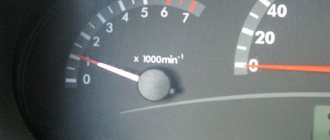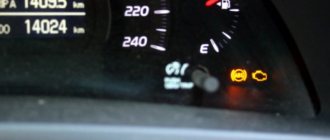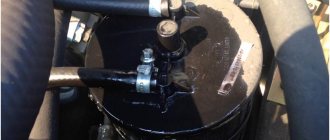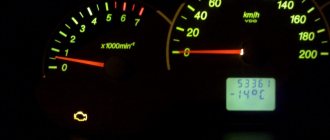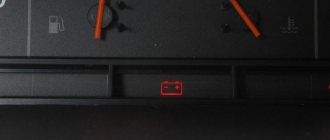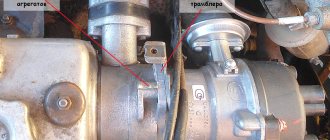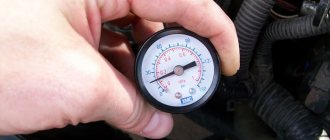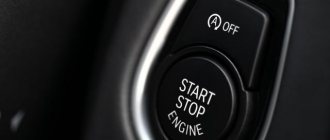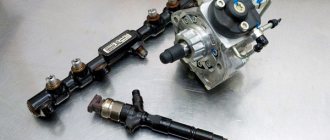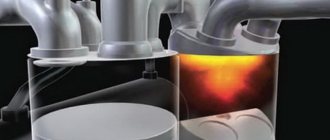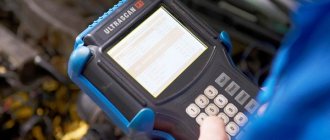By what signs can you determine that the engine is leaking?
Triple means that there is a problem with the engine, in which three cylinders are functioning normally, but the fourth one has malfunctioned. The fact that the engine is tripping can be determined by the following signs:
- At idle, the engine trembles and twitches constantly or periodically. Sometimes the shaking can get worse and the vibration can reach the steering wheel and gear lever, indicating a complete failure of one or more cylinders.
- Engine power has decreased. This affects increasing fuel consumption, frequent failures when pressing the gas and sudden shocks during acceleration.
- The “heartbeat” of the engine gets lost at idle, the sound either increases or decreases. Fluctuations in speed can be small (850-1000 rpm) or quite significant (from 850 to 1500 rpm).
- The exhaust produces sound jerks and pops instead of a smooth rumble.
Usually, when the engine stalls, you can notice several of the above signs at once, and the “Check engine” light also lights up. To clarify the error code, you need to contact a car repair shop, where they can decipher the fault data using a special diagnostic scanner, but you can also purchase such a device yourself.
Kia Rio “Check” caught fire: reasons
A modern car is crammed with electronics.
Multiple gauges and warning lights on the instrument panel indicate different faults. The most well-known signal is the “CHECK” function lighting up. This is an indication that there are problems with the operation of the engine or control unit. Video material
The video will tell and show how to fix a check engine light on a car.
Reasons for tripling
If the 3rd generation Kia Rio engine is malfunctioning, then the following malfunctions may contribute to this:
- injection of a lean or enriched fuel mixture, that is, an incorrect ratio of gasoline and air;
- malfunction of the ignition system - later or earlier;
- gradual wear of engine components or breakdown, which is accompanied by a decrease in compression levels.
To simplify the search for the cause of the Kia Rio power plant tripping, it is recommended to carry out the check step by step.
Trouble with KIA Rio 3 engine, check the ignition coil yourself, video
At one “wonderful moment” on my 2012 KIA Rio 3 began to stall , the dynamics disappeared and the “Check engine” (may flash). Another sign of a malfunction in the ignition system was rough engine operation and vibration. First of all, it was decided to remove the errors using an OBD2 scanner purchased on Aliexpress . As a result, a message was received with two errors P0300 and P0303 .
KIA Rio 3 engine troubles
Error P0300 - multiple misfires. Error P0303 (P0301, P0302, P0304) – multiple misfires in the third cylinder (the last digit indicates the cylinder number).
Reasons for the appearance of errors P0300 and P0303 on KIA Rio 3:
— a malfunction in the ignition system (ignition coil, spark plugs, etc.); — a malfunction in the fuel system; — air intake/exhaust system; — ignition timing angle.
KIA Rio 3 engine troubles
Causes and solutions
It is worth noting that on the Kia Rio, as on many other cars, the tripping effect is often caused by a violation of the air-fuel mixture, as well as ignition problems. Therefore, the main focus for identifying the causes must be placed on the nodes associated with the formation of the car’s power supply, as well as the ignition system.
Plugs, coils and module
The main cause of tripping may be faulty spark plugs. To eliminate the malfunction, you need to unscrew the elements from the spark plug well and check it using a stand. If there is no special equipment, then you can measure it using a tester, or the old “old-fashioned” method.
The second malfunction that causes the tripping effect is the coils. They must be checked in a car service center, or by measurement using a tester. Another diagnostic method is to look for sparks under the coils. But, this method only works in damp weather and at night.
The ignition module fails extremely rarely, but its malfunction can only be determined at a car service center.
Filters
Air and fuel filters can cause leakage. Faulty or clogged elements can lead to disruption of the formation of the fuel mixture, which in turn will lead to engine malfunction, as well as a number of breakdowns.
Fuel system
Clogged injectors and low-quality fuel will also cause a “triple” effect. This disrupts the formation of the fuel mixture, which can lead to increased wear of parts.
Sensor malfunction
Malfunction of sensors (temperature sensors, mass air flow sensor, crankshaft, camshaft, coolant). Thus, the malfunction can be easily eliminated by replacing the measuring element. To do this, you need to measure the sensor, or connect to the control unit and read errors.
Also, accumulated errors can cause tripping. For repairs, you need to go to a car service center and reset the data of the electronic control unit. If clearing the errors did not help, then you need to look for the error code where the malfunction is hidden.
Check light on KIA RIO 2013
To prevent engine checks, inspect the fuel filler cap frequently. Remember that sometimes the lid needs to be replaced with a new one!
An auto catalyst helps a car make engine exhaust gas emissions more environmentally friendly. It converts carbon monoxide and other harmful substances into harmless compounds.
The check on KIA RIO is on and off: what to do?
The next day, when I start the car, the check engine lights up. I unplug the wires and sit and smoke. After about 10 minutes, I start the car and the light is on. Well, I went to the official Kia Center Nizhnevartovsk. He arrived, explained the reason, asked about the mileage and drove to the “Fast Service”.
The serviceman connected the diagnostic connector using the Bluetooth principle and their program generated an error number, I don’t remember; in short: The catalyst bank is faulty; there is a wiring fault; there is a fault in the diagnostic oxygen concentration sensor installed on the corrugation.
troits engine
Owners of KIA Sportage (1994 – 2005)
Moderators: DimTS, Kuzka, Moderators
- Reply with a quote
troits engine
baton77 » April 11, 2012, 10:55 pm
in wet weather, it adjusts the engine at the bottom. Replacing the spark plugs and fuel filter did not bring any effect. As soon as it’s dry or frosty it runs smoothly. What the hell
baton77 Corporal Age: 43 Experience: 9 years 8 months 17 days Messages: 11 From: Kolomna Moscow Name: Alexey Car: kia sportage km petrol 2.0 4wd manual transmission Year of manufacture: 2010 Thanked: 2 times.
- Profile
- Private message
- Reply with a quote
Re: engine trouble
kubykk » Apr 11, 2012, 11:01 pm
baton77 wrote: in wet weather, it adjusts the engine at the bottom. Replacing the spark plugs and fuel filter had no effect
And the explosive wires were not changed
Soon we will live even better... because deputies Pronin and Mamonov think about us... (Our Russia) ________________________________________________________________________________________________ Kia-Hyundai service in Kostroma, qualified specialists, low prices, tubers are given a discount, tel: 8-903-897-90-56 ,8-960-740-16-14
kubykk Lieutenant Colonel Age: 42 Experience: 12 years 5 months 19 days Messages: 2597 From: Kostroma Region 44 RUS Articles: 3 Name: Dmitry Car: Kia Rio 2 Year of manufacture: 2004 Thanked: 77 times. Awards: 3
- Profile
- Private message
- Personal album
- Reply with a quote
Re: engine trouble
4500043 » April 29, 2012, 02:05
Maybe check the wiring... moisture gets in and short-circuits something, I actually had a poltergeist... I took apart the floor of the car to understand the reason (it twitches, does not pull). In short, the air conditioner drain was clogged (from where condensate drips onto the street when the air conditioner is running (rubber tip) and water flows right onto the largest connector of the engine ECU - this results in a system failure and 2 months of wandering around diagnosticians). I removed the blockage, dried the contact - the bird flew away
4500043 Private Experience: 8 years 10 months 6 days Messages: 1 Name: Sanya Car: Sportage JA Year of manufacture: 1993
- Profile
- Private message
- Reply with a quote
Re: engine trouble
Sergey81 » November 25, 2012, 00:02
Hello everyone. I also have a problem, the car was parked for a month, when I started it, it started to misfire, when it warmed up, it stopped, in the evening it started up again, and it stayed that way, both warm and cold. You keep the revs constant - 3000-3500, it doesn’t stall, but at idle it does. What's the matter? When you press the pedal, failure. I replaced the spark plugs, the filter, the air vent, I'm sinning on the 4th cylinder - it works with failure, at 3500 it's normal, I'm thinking of what else to replace. Wires or coils? Please tell me what is the problem?
Sergey81 Private Experience: 8 years 3 months 10 days Messages: 4 Name: Sergey Car: KIA Sportage Year of manufacture: 1994
- Profile
- Private message
- Reply with a quote
Re: engine trouble
VictorC » 26 Nov 2012, 15:35
Sergey81 wrote: Hello everyone. I also have a problem, the car was parked for a month, when I started it, it started to misfire, when it warmed up, it stopped, in the evening it started up again, and it stayed that way, both warm and cold. You keep the revs constant - 3000-3500, it doesn’t stall, but at idle it does. What's the matter? When you press the pedal, failure. I replaced the spark plugs, the filter, the air vent, I'm sinning on the 4th cylinder - it works with failure, at 3500 it's normal, I'm thinking of what else to replace. Wires or coils? Please tell me what is the problem?
The injectors need to be cleaned.
VictorC Junior Sergeant Experience: 13 years 4 months 14 days Messages: 38 From: RB Thanked: 5 times.
- Profile
- Private message
- Reply with a quote
Re: engine trouble
Panzer38 » 26 Nov 2012, 17:33
Sergey81 wrote: Hello everyone. I also have a problem, the car was parked for a month, when I started it, it started to misfire, when it warmed up, it stopped, in the evening it started up again, and it stayed that way, both warm and cold. You keep the revs constant - 3000-3500, it doesn’t stall, but at idle it does. What's the matter? When you press the pedal, failure. I replaced the spark plugs, the filter, the air vent, I'm sinning on the 4th cylinder - it works with failure, at 3500 it's normal, I'm thinking of what else to replace. Wires or coils? Please tell me what is the problem?
The injectors need to be cleaned...
Sportage Grand. AUTOTOR. 2006. blue... was. Now Mitsubishi Pajero Sport II 3.2d DI-D 2008. BLUE Ant on Drive
Panzer38 Lieutenant Colonel Age: 52 Experience: 14 years 7 months 9 days Messages: 2542 From: Moscow Name: Sergey Car: Mitsubishi Pajero Sport II Year of manufacture: 2008 Thanked: 517 times. Awards: 4
- Profile
- Private message
- Website
- ICQ
- Personal album
- Reply with a quote
Re: engine trouble
romych83 » November 30, 2012, 12:19 pm
Good day, as a matter of fact, I would start with compression in the cylinders! Then everything gets more fun, we disassemble the timing belt and look at the crankshaft key, if everything is in order - the fuel tank, its line, pump + grid, injectors + intake manifold gaskets! and lastly, if there is a catalyst!
Repair and maintenance of Kia and Hyundai cars!!! Moscow Panteleevskaya st. 14 building 1 8-915-322-46-25 Roman
romych83 Representative of LLC “5x5” Age: 38 Experience: 9 years 10 months 8 days Messages: 71 From: Moscow Name: novel Car: cerato Year of manufacture: 2005 Thanked: 2 times.
- Profile
- Private message
- Reply with a quote
Re: engine trouble
Sergey81 » 10 Dec 2012, 17:05
I DID EVERYTHING))))))))))) I disassembled the intake manifold, replaced the gasket, cleaned the injectors at the same time, and now that’s it)) Now there’s another problem - it started consuming fuel (((( WHY???The check is not lit. HELP!!
Sergey81 Private Experience: 8 years 3 months 10 days Messages: 4 Name: Sergey Car: KIA Sportage Year of manufacture: 1994
- Profile
- Private message
- Reply with a quote
Re: engine trouble
romych83 » 10 Dec 2012, 17:24
Is the engine running smoothly?
Repair and maintenance of Kia and Hyundai cars!!! Moscow Panteleevskaya st. 14 building 1 8-915-322-46-25 Roman
romych83 Representative of LLC “5x5” Age: 38 Experience: 9 years 10 months 8 days Messages: 71 From: Moscow Name: novel Car: cerato Year of manufacture: 2005 Thanked: 2 times.
- Profile
- Private message
Return to Sportage JA
Go to:
Who's at the conference now?
This forum is currently viewed by: no registered users and guests: 6
What does a lit Check Engine light on a Kia Rio mean?
Check Engine on Kia Rio
On Korean Kia Rio cars, a burning CHECK ENGINE light on the dashboard indicates that there is a problem with the operation of the components.
Check came out
When does the check light come on?
- with the ignition on before the power plant starts (normal);
- at the moment of starting the engine;
- in the event of a malfunction of the system that controls the exhaust of the car (in case of problems with the internal combustion engine and gearbox).
The situation is considered normal when, after starting the internal combustion engine, the check goes out and does not light up while driving. If the light on the dashboard is flashing, the catalytic converter may be damaged; driving a car in this condition (without inspection and testing at a service center) is fraught with aggravation of the problem and more serious damage. In the operating manuals for Kia Rio of the second and third generations, the manufacturer indicates that a flashing check indicates a malfunction in the working units that control the process of reducing exhaust gas toxicity. Driving such a car is allowed, but a visit to an official dealer is absolutely necessary.
What to do if the Check Light on a Chevrolet Cruze lights up
You can solve the problem with a burning check lamp on your own; no special effort or tools are needed. If the check light on the Cruze does not light up and the car does not start:
You need to change the lambda probe (another name for the oxygen sensor). It is responsible for removing waste exhaust gases, controls oxygen consumption, and helps regulate these processes. Any malfunctions indicate that the computer is receiving incorrect data, and this, in turn, helps to increase fuel consumption and maintains engine power at optimal levels. There are usually from 2 to 4 sensors; the easiest and fastest way to carry out checks is using a special scanner. The reasons for the incorrect operation of the lambda probe are natural wear and tear over time. Repair or replacement is mandatory, otherwise a faulty sensor will lead to breakdown of the catalyst, and this is associated with considerable repair costs. You should check the fuel tank cap - if the Chevrolet Cruze Engine check light is on, the connection is probably not tight enough. The tightness of the fuel system must meet current requirements; violations are likely to result from incomplete tightening of the fuel tank cap. Also, a leak in the system increases fuel consumption and causes a signal to appear on the dashboard. Additionally, the tank cap is replaced with a new one from time to time. You need to make sure that the exhaust catalyst is in order - it increases the environmental friendliness of the car by converting carbon monoxide and other toxic substances into harmless components. If the catalyst fails, the car's power will drop by half. Regular vehicle maintenance in accordance with regulations will extend the service life of the system. Problems with the catalyst are caused by untimely replacement of the oxygen sensor and regular changes of ignition mixtures. A malfunction of the unit makes normal movement by car impossible in principle. Repairs are absolutely necessary; it is best to have them done by specialists. Check the mass air flow sensor - it is responsible for the volumes that are added to gasoline mixtures in order to correct the strength of the fire. The sensor transmits information about the volume of supplied oxygen mixture to the computer. If it is faulty, consumption will increase, CO2 in the exhaust will increase, engine power will decrease, and the smoothness of the current ride will deteriorate. If the sensor is faulty, poor acceleration dynamics are likely; difficulties almost always arise with starting the engine in cold weather
It is important to install the element correctly, since improper installation also leads to problems. Over time, the sensor wears out; this cannot be avoided.
It is possible to carry out maintenance work on your own. Replace spark plugs - they are responsible for igniting fuel mixtures; in case of malfunction, it becomes difficult to supply a spark. If the spark plugs do not function correctly during acceleration, you may feel noticeable small shocks. The average resource of nodes is 25 thousand km, rarely more. Problems will be indicated by regular system performance testing. If there are no scheduled replacements of engine spark plugs, problems are inevitable. Self-service is possible without contacting service. Vehicle performance will improve and fuel consumption will decrease. The exact replacement schedule is specified in the operating manual for each vehicle.
READ Which Seats Suitable For Renault Logan 1
The check light for a Chevrolet Cruze 1.8 automatic lighted up - it’s not a problem yet. First you need to make sure that high-quality fuel is filled in and the tank cap is screwed on properly. Then you can perform other independent manipulations and contact the service center.
Self-check control can be done using a smartphone; to perform serious restoration work, it would be better to contact the service
Important! If you do not ignore the need to perform regular maintenance, you can significantly reduce the risk of various breakdowns, including a malfunction of the check system on the Chevrolet Cruze.
Scheduled maintenance is not a 100% guarantee of performance, but it significantly reduces the likelihood of problems.
Why does the check on Kia RIO blink?
When the check light is on on the Kia RIO and the engine is running normally, you need to carry out step-by-step testing of the system. First, they slow down the car, then listen carefully to the sounds made by the engine. Separately, the condition of the oil in the system is assessed, and the sides of the engine are checked. If there are no visual defects, but blinking is present, you should go to a service station for a comprehensive diagnosis.
The ignition system settings should be checked. To do this, inspect the working coil, then the spark plugs. Be sure to look at the quality of the fuel mass inside the system. When checking with your own hands, you must accurately identify the problem, otherwise it will not be possible to fix it.
The signs on the panel must be constantly observed in order to take immediate action if necessary.
Errors P0300, P0301, P0302, P0303, P0304
If the engine is misfiring, the scanner often shows error code P0300, which indicates a violation of the ignition order, namely multiple misfires. When misfires are detected in a specific cylinder, the last digit of the error will indicate the problem cylinder, for example, P0302 means multiple misfires in the 2nd cylinder.
In practice, this means that in one of the cylinders the fuel does not burn completely and enters the exhaust system, risking damaging the catalyst. This device is designed to clean exhaust and is a rather expensive and vulnerable element. It consists of small cells that can melt if the remaining fuel burns out in the catalyst. As a result, gases will not be able to pass through it freely, and a plug will form in the exhaust pipe. Hence all the above symptoms. Also, the catalyst will stop purifying the emissions, which will lead to increased exhaust toxicity.
What to do if the Check Engine light is on or flashing on a Kia Picanto?
The Check Engine indicator is available on most modern cars and it lights up when malfunctions or any problems appear in the engine, which include: breakdown of sensors, misfires, damage to drive belts, etc. Typically, such malfunctions are discovered during a routine inspection or diagnosis of the car, and these problems are resolved there.
The Kia Picanto dashboard also has such a light, but in addition to the usual reasons, the model has its own specific case, which few people know about. First, let's look at the symptoms that appear exclusively on a warm engine idling.
The engine is misfiring due to the ignition system
Most often, the 3rd generation Kia Rio engine fails due to a malfunction of the ignition system.
The spark plugs must be unscrewed and inspected, paying attention to the integrity of the porcelain insulation and the compliance of the gap on the electrode. If chips, cracks or poor clearance are detected, the damaged spark plug should be replaced.
Checking the spark plugs
Also, the cause of motor tripping can be high-voltage wires that supply power to the spark plugs.
As a rule, failure of wires is accompanied by engine tripping in rainy weather. In this case, the malfunction disappears after the motor reaches operating temperature. This is due to the fact that the wire insulation is made of rubber, which cracks over time and allows current to pass through.
High voltage wires
The next element that you need to check is the coils.
If the ignition coils are faulty, error p0300 will be recorded (p0301 last digit is the cylinder number). To check the coil yourself, you should remove it along with the spark plug and press the spark plug electrode firmly against the ground. After this, start the power plant and look for a spark. It is necessary to ensure reliable contact of the spark plug electrode with the ground, otherwise the switch or the coil itself may burn out.
Ignition coils
The least likely factor in the malfunction of the 3rd generation Kia Rio power unit is a breakdown of the electronic ignition distributor.
What's the result?
As you can see, if the engine stalls and the check engine light blinks, it is necessary to determine the cause as quickly as possible. A timely call for service or repairs will allow you to avoid subsequent troubles with the catalyst and lambda.
It must be remembered that tripping and misfires do not always indicate a serious breakdown. In some cases, it is enough to replace the spark plugs or explosive wires, while in others the engine still needs to be repaired.
In this case, the spark on the candles will be normal, the injectors will also supply fuel, the compression measurement will not reveal any deviations from the norm, but the “check” in this case will still blink or blink.
Reasons for errors
There can be several reasons for error P0300:
- Flaw in the power system
- Malfunction in the air intake/exhaust system
- Defect in electronic control system
But the most common source of the problem is defects in the operation of the ignition system, so it is worth checking each element carefully:
- Candles. Almost half of the cases when the engine stalls are associated with spark plugs. Upon inspection, they should be light in color, without traces of soot or damage. If everything is in order, it is enough to clean them, but if in any doubt it is better to replace them with new ones.
- High voltage wires. They also often fail, for example, the insulation is broken, and the spark may not reach the spark plug. Wires should be checked regularly and replaced if necessary.
- Ignition coil. A faulty ignition coil requires immediate replacement.
- Other problems related to wiring in the ignition system.
If the check engine light comes on: 5 most common reasons for the indicator to turn on
Many of us have encountered such a problem as turning on the engine icon (Check engine...), the appearance of which frightens car drivers. We offer you the 5 most common reasons why the check engine light comes on on the dashboard.
The engine warning light usually appears without warning. The reason for the appearance of the Check engine cannot be immediately understood. Even if the car has auto diagnostics (for example, in cars such as BMW, Audi, Porshe, Mercedes-Benz, VW), which scans all car systems for errors and, if any, displays a decryption on the information panel, the reasons for the check engine light will not be decrypted .
For most drivers, the appearance of this warning icon on the dashboard means the need to urgently go to an auto repair shop to diagnose and eliminate the reason why the “Check Engine” warning sign appeared. But in fact, in most cases, when the “Check” indication appears, you can independently diagnose the cause of the engine failure and, in some cases, possibly eliminate the cause yourself without a trip to a car service center, which will save you money.
Car exhaust catalyst
An automobile catalyst helps a car make engine exhaust gases more environmentally friendly. It converts carbon monoxide and other harmful substances into harmless compounds. If your exhaust catalyst has become unusable, you will notice it not only when the engine icon (check) appears, but also long before that, when the car’s power drops by half. For example, when you press the gas pedal, the car will not have good acceleration dynamics as before.
What can cause a car catalyst to fail: if you regularly service your car in accordance with the car company's maintenance regulations, then the catalyst should not fail. The reason for the failure of the catalyst is the untimely replacement of a faulty oxygen sensor, as well as non-regular replacement of spark plugs when the expiration date expires. When the oxygen sensor or spark plugs are faulty, the conversion of carbon monoxide in the catalyst into harmless chemical elements stops, which leads to overheating of the catalyst, which can therefore fail.
What needs to be done: If your catalyst has become unusable, then you cannot drive a car, since the engine will not work correctly, warning about this by an indication on the dashboard with an engine icon (check). Also, your fuel consumption will be greatly increased, and there will be no engine thrust. Although replacing a catalyst is a very expensive repair, there is no escape from repairs.
Although there is an alternative to replacing the catalyst with a flame arrester, this is not a 100 percent option. Unfortunately, if you are not an experienced auto mechanic, you will not be able to replace a faulty exhaust gas catalyst yourself. In any case, you will have to contact a car repair shop.
Remember that timely replacement of oxygen sensors and spark plugs protects your catalyst from damage!
Replacing spark plugs and high-voltage wires
Spark plugs in a car are the main components for igniting the fuel mixture. If the spark plugs are faulty, the spark will not be supplied correctly to ignite the gasoline mixture. Faulty spark plugs often result in a lack of spark or an incorrect spark interval, which results in the engine not running properly. If the spark plugs do not work properly during acceleration, especially from a standstill, you may feel slight jolts.
What are the reasons for spark plug failure: Most spark plugs in cars produced before 1996 need to be changed every 25,000-30,000 kilometers. In newer cars, spark plugs last more than 150,000 km. However, these scheduled spark plug replacement intervals may be reduced by various factors related to fuel quality and driving style.
What needs to be done: If your spark plugs have not been changed for a long time, or you feel failures in the engine operation associated with ignition, then you must immediately replace them with new ones without delay. Do not try to save money by untimely replacement of spark plugs, since the cost of spark plugs is not very expensive, as well as the work of replacing them. By replacing old spark plugs, you will improve engine performance and reduce your vehicle's fuel consumption. Changing spark plugs yourself is quite easy.
Basically, they are easily accessible under the hood of the car. You need a regular spark plug wrench to remove the spark plugs from the engine. It is also advisable to monitor the condition of high-voltage wires, since over time they can become unusable and allow electricity to pass through, which is transferred to the spark plugs, which will reduce the strength of the spark.
READ Error P0341 Honda Accord 8
Remember that regularly replacing spark plugs, in accordance with your car’s maintenance schedule, protects your exhaust catalyst from breakdowns and also improves engine performance!
This article was originally published in 2013 and updated with new information on 02/17/2020.
The engine stalls, the check light flashes or lights up: the main reasons
Let's start with the fact that injection engines are equipped with special catalyst devices for cleaning the exhaust. At the same time, the catalytic converter is a rather vulnerable and at the same time expensive element, and all sorts of malfunctions in the engine create a risk of damage.
As a rule, the check flashes when there is a risk of damage to the catalyst. In this case, the simultaneous tripping of the engine means that one or more cylinders are not working or are not working correctly. In practice, this means that the fuel in the problem cylinder does not burn completely, after which it enters the exhaust system.
As a result, the remaining unburnt fuel burns out in the area where the catalyst is located, since the temperatures there are very high. Fuel also gets on the catalyst itself, causing it to fail.
It becomes clear that the check often lights up when problems arise with the combustion of the mixture in the cylinders. It is not difficult to guess that such combustion can be disrupted for a number of reasons, ranging from problems with the ignition or fuel supply system to lack of air in the intake, air leaks, reduced compression in the engine cylinder, etc.
It should be added that the check also often lights up in the event of failure of any ECM sensors. One way or another, it is quite obvious that the “check” in the vast majority of cases indicates either problems with the electronic engine control system itself, or the risk of damage to the catalyst due to malfunctions of the internal combustion engine.
It is important to understand that the engine tripping indicates a non-functioning cylinder. In this case, the check is flashing not due to the failure of any ECM sensor, malfunction of the exhaust gas recirculation system or poor fuel in the tank, but rather signals to the driver about a direct threat to the catalyst.
In a nutshell, fuel that is not burned and gets into the outlet causes a special sensor (lambda probe, oxygen sensor) to send readings to the ECU indicating deviations from the norm. The control unit begins to try to correct the situation, but taking into account the tripping, it is simply not able to adjust the operation of the motor so that everything returns to normal. As a result, fuel consumption increases, while the engine operates unstably, idle speed fluctuates, etc. In some cases, the motor “falls” into emergency mode.
This mode is necessary in order to minimize damage to the catalyst and the internal combustion engine itself. In practice, this is expressed in such a way that although the driver presses on the gas, the car in emergency mode with the “check” on still does not accelerate above 30-40 km/h, the crankshaft does not spin up, engine traction disappears, etc.
This feature of engine operation is primarily aimed at preventing burnout or melting of the catalyst. The catalyst itself consists of small honeycomb cells. If unburned fuel intensively enters the exhaust and burns out in the catalyst, the element will simply melt.
The check blinks and does not pull Hyundai Solaris Kia Rio. No diagnostics needed!
This melting will lead to the fact that exhaust gases will not be able to pass normally through the catalyst, that is, a plug appears in the exhaust pipe. Naturally, the engine will “suffocate”, power will drop, the engine may not start at all, etc.
Also, the catalyst will no longer be able to clean the exhaust, and toxicity will increase. There is only one way out in this situation - repairing the engine to eliminate the main cause of the engine tripping, and only then replacing the expensive catalyst with a new one. To minimize risks, a special program is programmed into the ECU, which involves operating the engine in emergency mode.
Check the fuel filler cap
Many drivers, in most cases, when the “check engine” indication appears, will think about serious problems in the car’s engine, but will not even think to check the tightness of the fuel system, which may be compromised due to a defect or an insufficiently tightened fuel tank cap. This is a very common reason for the appearance of the “Check” engine icon.
Reason for the error: Leakage of the fuel system due to the passage of air through the filler cap of the fuel tank will increase the vehicle's fuel consumption, to which the vehicle's diagnostic system will generate an engine error by turning on the "Check engine" indication on the vehicle's instrument panel.
What needs to be done: If, when the “Check” indication appears, your car has not lost power, and there are no audible signs of engine damage (engine knocking, humming, creaking, etc.), then first check the gas tank for leaks. Your gas cap may be cracked or not tightened enough.
If the cap was not tightened enough, then after tightening it all the way, continue driving the car for a while to see if the engine error disappears. To prevent a check engine light from appearing for this reason, check your fuel filler cap regularly.
Remember that the cover must be replaced with a new one periodically!
mav59946
Newbie
Well, first of all, don’t refuel at Lukoil - the gasoline there is very lousy. Have you tried changing the high-voltage wires? It might be worth cleaning the injector.
Reasons for the appearance of errors P0300 and P0303 on Kia RIO 3:
— a malfunction in the ignition system (ignition coil, spark plugs, etc.); — a malfunction in the fuel system; — air intake/exhaust system; — ignition timing angle.
The reason for engine tripping is incorrect air supply
The 3rd generation Kia Rio engine also triples due to a reduced or increased volume of air supplied to the cylinder. Excess air mixture is not taken into account by the electronic engine control unit. They arise due to a violation of the tightness of the air tract circuit. A lack of air supplied to the Kia Rio cylinders may occur due to contamination of the air filter element or throttle valve.
Factors influencing the formation of air supply:
- malfunction of the throttle position sensor;
- failure of the mass air flow sensor.
Throttle valve
The result is interruptions in the electronic control unit of the power plant. It cannot correctly determine the degree of throttle opening or the ratio of the supplied fuel mixture. To accurately determine the faulty sensor, you will need to carry out diagnostics.
Underwater rocks
If the “CHECK” light comes on in a Rio of any generation, then don’t panic. Often on cars the signal is supplied from a common ECU, which, like any computer, can malfunction. This may be caused by a short circuit or replacement of electrical circuit components. Therefore, errors occur in the electronic control unit, which can serve as a “CHECK” signal.
This problem is quite easy to treat. The ECU itself needs to be connected to a software laptop and errors in the system should be corrected or outdated firmware changed. It is best to entrust this operation to specialists who know how it is done.
Debugg
You can fix the problems yourself, but the optimal solution is to undergo computer diagnostics of the Kia Rio. Options for the car owner:
- replacement of spark plugs, which are responsible for igniting the air-fuel mixture in the combustion chambers (consumable life is 20-30 thousand km);
- replacing the residual oxygen sensor (lambda probe), if it malfunctions, the on-board computer receives incorrect information about the state of the car (as a result, the performance decreases, the consumption increases, and the Kia Rio’s dashboard displays a burner);
- checking the tank cap and changing the gas station (the quality of the fuel plays a role; sometimes the CHECK light is on because of the fuel)
- checking the ignition coil and wires (resistance and presence of spark are determined).
If the Check light comes on and you have an amateur car scanner at hand, you can arrange a check and then fix the problem yourself. If difficulties arise, it is better to contact the service.
Resetting the error
When the check light is on for a Kia Rio, a check is required and then the problem is fixed.
Don't ignore the flashing light on your dashboard.
After completing the work, you will need to reset the error. In a car service center, the reset is carried out by a diagnostic computer . The service technician will fully diagnose the car, so it is better not to neglect this procedure as part of maintenance. Resetting the device is intuitive; all you need to do is follow the prompts .
Troubleshooting Kia Rio
How to reset an error on a Kia Rio?
If it is not possible to take the car to a service center, then a scanner will come to the driver’s aid, allowing you to clear errors. There are different models: some work autonomously if they have a screen, some connect to smartphones via Bluetooth.
The cost of simple models is low, from 2000 rubles, and it pays off, especially if serious faults are identified. If there is no scanner at hand to remove the receipt, many car owners take the path of disconnecting the battery for about a day. In this case, the latest faults are erased from the memory of the on-board computer and thus do not threaten blocking.
There is another way to reset a check. To implement it, you will need a paper clip and access to the manufacturer’s website, to the page with error codes.
- turn off the car;
- find the diagnostic connector located to the right of the fuse box;
- close pins 4 and 9 of the OBD-II connector;
- turn the ignition back on;
- count long and short lights on to identify the error code. Long ones represent tens, short ones – ones. Write down the resulting two-digit number;
- find an error on the website, find out which vehicle system it relates to;
- ABS system malfunction is reset by pressing the brake pedal several times within 4 seconds until the error code indicator disappears.
We check and, if necessary, replace ignition coils
Coils are fairly reliable elements of the ignition system with a long service life. They usually fail due to an insulation breakdown, which is easy to check yourself:
- Inspect the coil for damage - an insulation breakdown will be visible to the naked eye.
- If the coil is intact, you can swap it with another to see if the error moves to the other cylinder.
- Next, measure the resistance of the primary winding of the coil using a multimeter. A working part will show 0.75 Ohm ± 15%. If the value is less, this indicates a short circuit due to a violation of the winding insulation. If the readings are too high, then the winding wire has broken and there is no full contact.
In the latter case, the coils can be repaired, but it is easier and more expedient to replace them.
